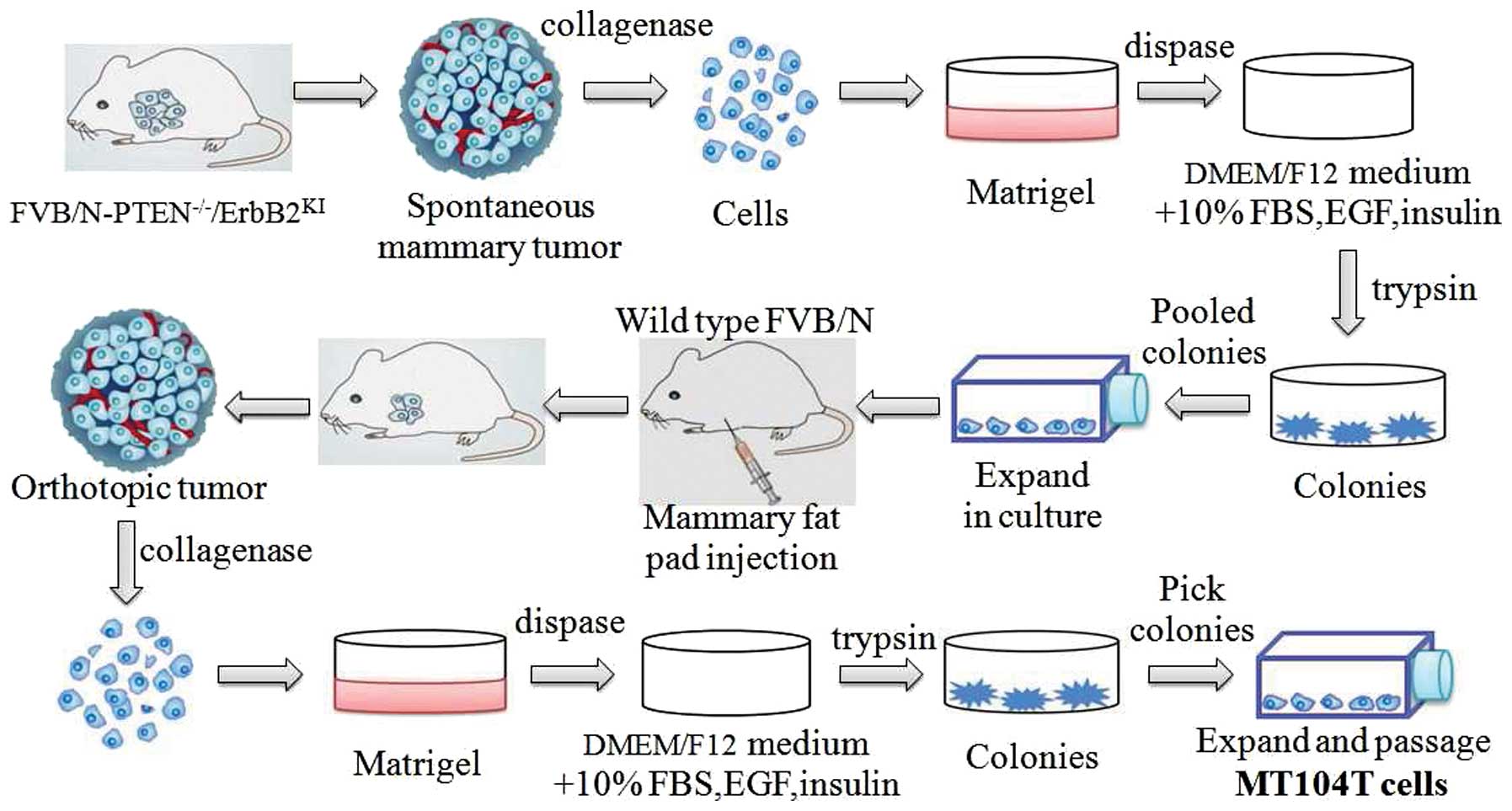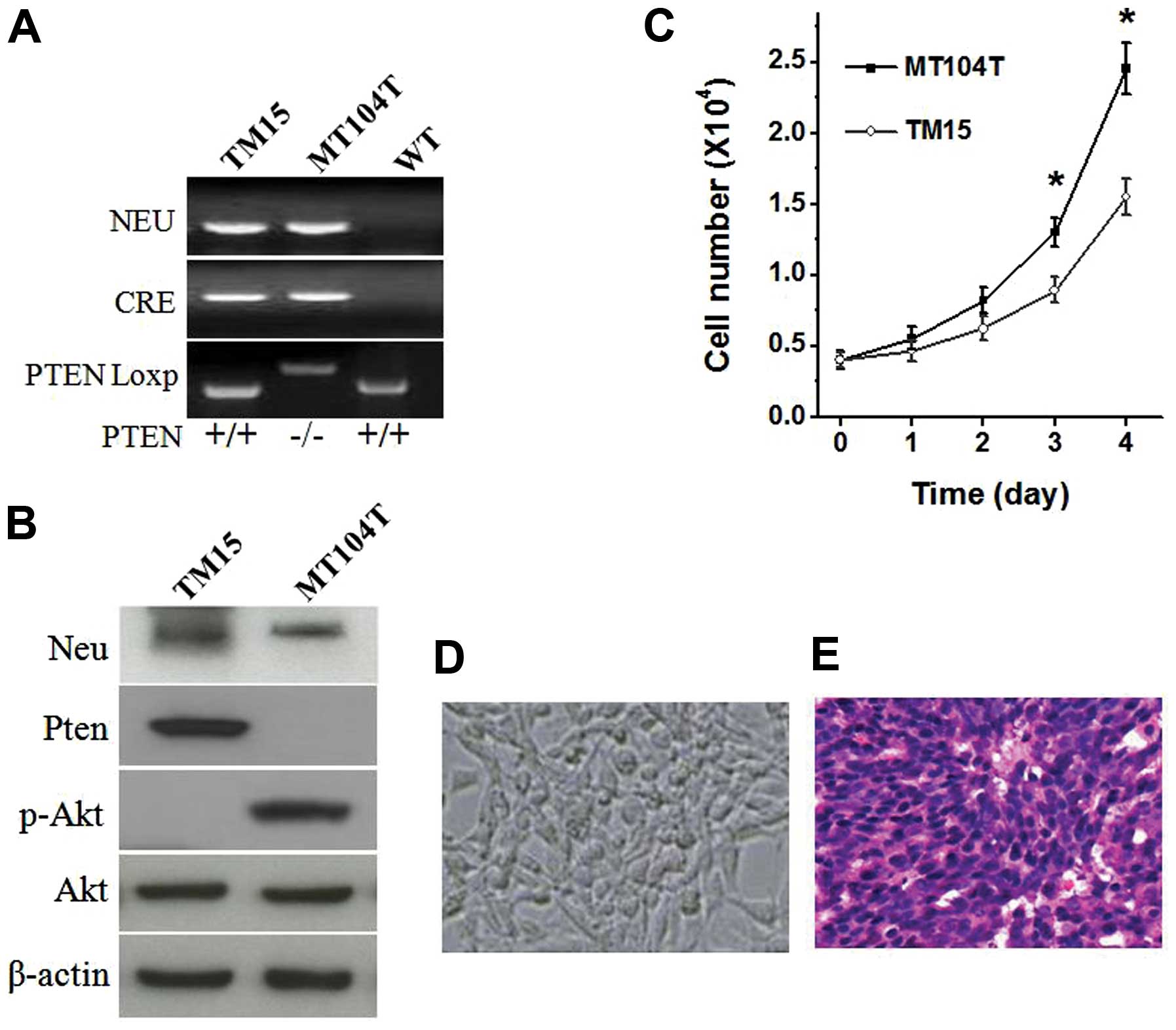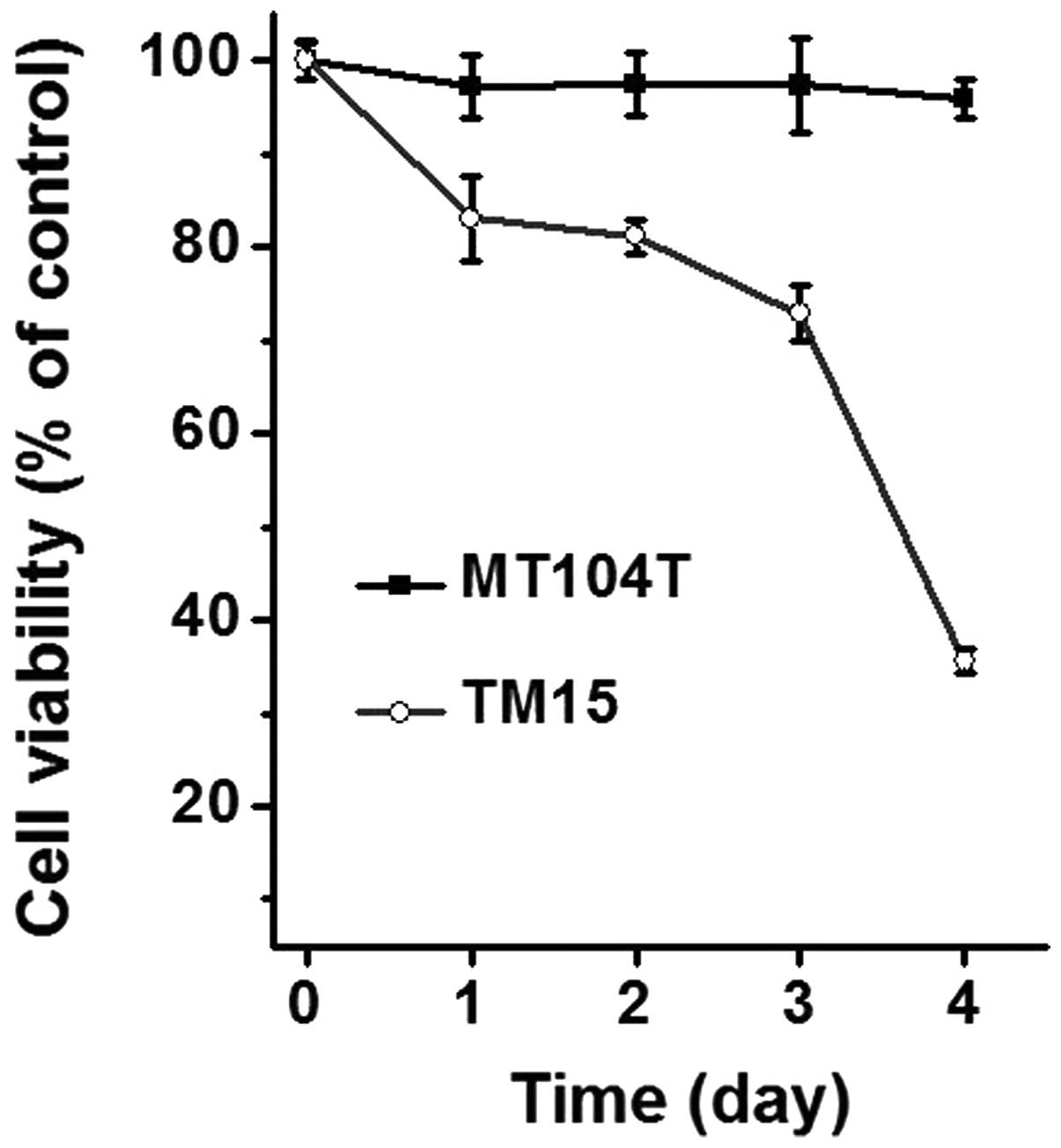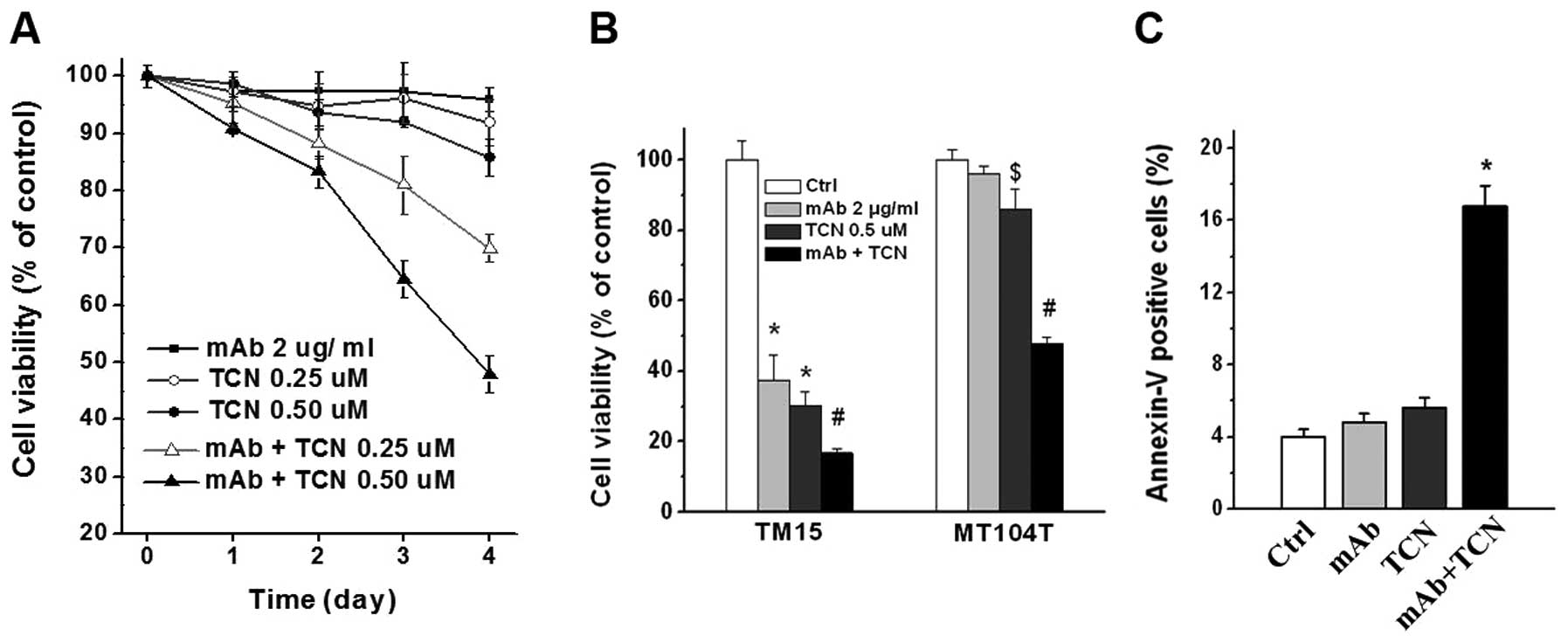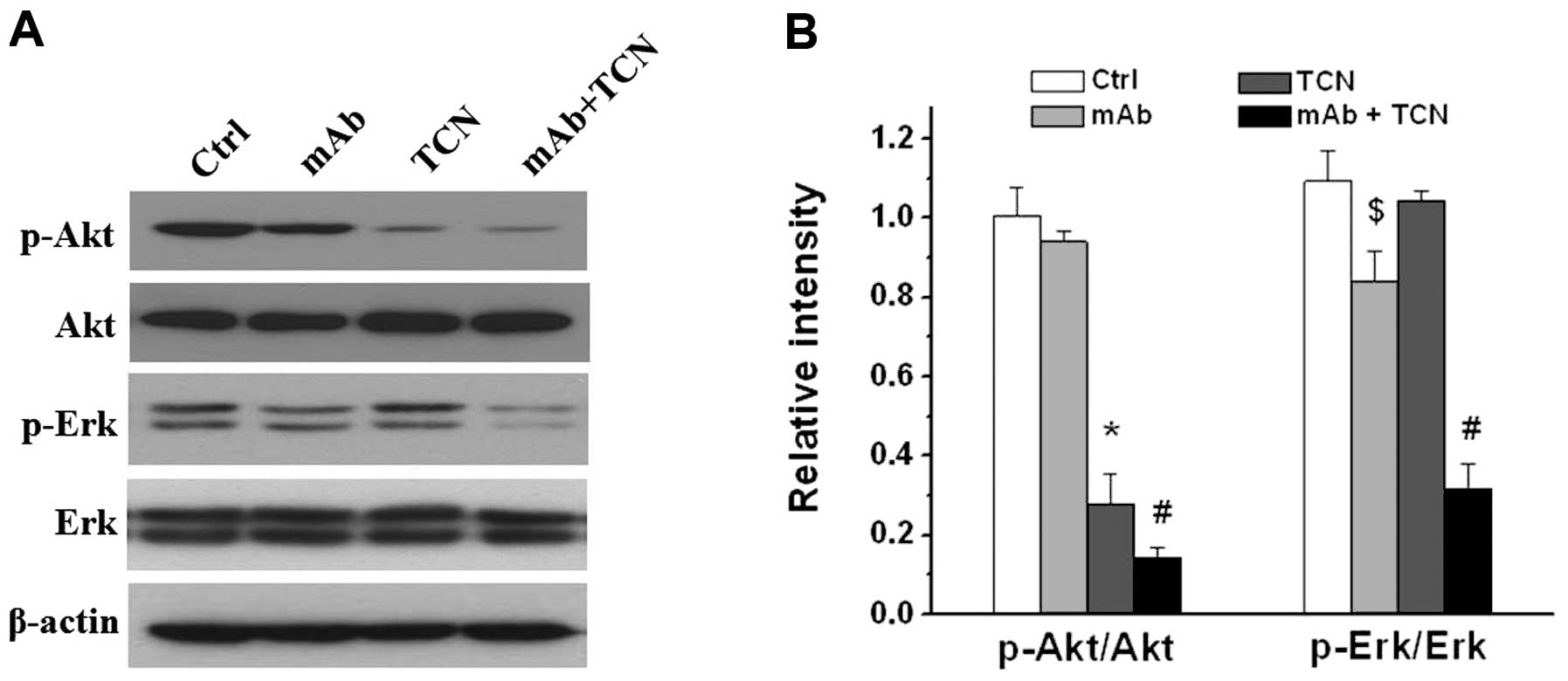Addition of the Akt inhibitor triciribine overcomes antibody resistance in cells from ErbB2/Neu-positive/PTEN-deficient mammary tumors
- Authors:
- Published online on: January 21, 2014 https://doi.org/10.3892/ijo.2014.2271
- Pages: 1277-1283
Abstract
Introduction
Breast cancer is one of the most frequently diagnosed cancers and remains the second leading cause of cancer deaths in women (1). Understanding the nature of breast cancer is of central importance in development of novel therapies or improving existing therapeutics for the treatment and prevention of this disease. Breast cancer is a complex and heterogeneous disease, as evidenced by the diverse histopathological features, the various responses to therapy, and the identification of subtypes with distinct clinical outcomes by molecular profiling (2–5). One of the common subgroups is the ErbB2-positive subtype, which occurs in up to 30% of breast cancers and often is associated with poor patient prognosis (6,7). Trastuzumab (Herceptin), a humanized monoclonal antibody targeting the extracellular domain of ErbB2/HER2, has remarkable clinical efficacy in ErbB2-positive breast cancer (8–10). However, the unresponsiveness to initial trastuzumab-containing regimens (primary resistance) and development of therapeutic resistance after continuous treatment (acquired resistance) in a significant number of patients is a current challenge (11,12).
Several potential mechanisms of trastuzumab resistance have been identified (13,14). Hyperactivation of phosphatidylinositol 3-kinase (PI3K)/AKT pathway is one of key trastuzumab resistance mechanisms (13–15). The lipid phosphatase and tensin homolog (PTEN) is a one of the most mutated and deleted tumor suppressors in human cancer (16). Loss of PTEN or the loss of its function are also common in breast cancer, which results in the hyperactivation of PI3K/AKT pathway (17). Previous evidence suggests that loss of PTEN conferred significant trastuzumab resistance through enhanced PI3K/AKT signaling in ErbB2-overexpressing breast cancers (18–20). These studies implicate that PI3K/AKT targeting combination therapies could combat trastuzumab resistance. In addition, several potential agents are being evaluated intensively (21).
Previously, we reported that combining the small-molecular PI3K/AKT inhibitor triciribine (TCN) with ErbB2/Neu antibody effectively inhibited tumor growth and overcame trastuzumab resistance in two distinct PTEN deficiency-mediated trastuzumab resistance mouse models (22). One of such models was PTEN−/−/ErbB2KI genetically engineered mice (23,24), obtained by interbreeding with three types of mice including ErbB2KI mice (23), MMTV-Cre mice and the flox-PTEN mice. To avoid the major disadvantages of this model (such as long tumor latency, high cost and time- consuming) and complement our genetic engineering approach, in the present study, we attempted to establish cell lines isolated from spontaneous mammary tumor that arose in the PTEN−/−/ErbB2KI mice. We report that one such cell line, designated MT104T, maintained the molecular phenotype and induced a tumor with similar histomorphology as its origin in syngeneic FVB/N mice. Then, we found the MT104T cells conferred resistance to anti-ErbB2/Neu antibody treatment due to PTEN loss-mediated Akt hyperactivation. We next found that addition of Akt inhibitor triciribine (TCN) effectively inhibited the viability and induced apoptosis of MT104T cells, via inhibiting both PI3K/Akt and mitogen-activated protein kinase signaling. Our results confirmed the efficacy of combination treatment with ErbB2/Neu antibody and TCN for overcoming trastuzumab resistance by PTEN deficiency, providing insight into the development of more personalized therapies for HER2/ErbB2-positive breast cancer.
Materials and methods
Cell lines and cell culture
TM15 and MT104T cells were cultured in growth medium (DMEM/F12 with 10% FBS,5 μg/ml insulin, 10 ng/ml epidermal growth factor (EGF), 1 μg/ml hydrocortisone, 35 μg/ml bovine pituitary extract and 100 U penicillin/streptomycin). Cell number was evaluated on a cell counter. TM15 cells were established from a spontaneous ErbB2/Neu-positive-PTEN wild-type (PTEN+/+/ErbB2KI) mammary tumor (23,25). MT104T is an immortalized ErbB2/Neu-positive-PTEN-deficient carcinoma cell line generated from mammary tumor of PTEN−/−/ErbB2KI genetically engineered FVB/N female mouse (22,24). To establish MT104T cell line, fresh mammary tumors from PTEN−/−/ErbB2KI mice were excised and minced with sterile scissors into approximately 1- to 2-mm3 pieces, then digested in DMEM/F12 medium containing 10% FBS, 2 mg/ml collagenase (Sigma), 0.02 mg/ml hyaluronidase (Sigma), and 0.01 mg/ml DNase I (Sigma) for 3 h at 37°C with gentle agitation. The supernatant was filtered through 40 μm mesh cell strainer (BD Biosciences) to remove clumps. Red blood cells were removed by treatment with ACK buffer and washed with cold DMEM/F12. The cells were resuspended and cultured in DMEM/F12 containing 40% Matrigel (BD Biosciences). After 2 weeks, cells were recovered by dispase (Sigma) treatment at room temperature and cultured in growth medium for 24 h. Single cells, generated by digestion with 0.05% trypsin (Invitrogen) were plated at 1,000 cells per 10-cm dish. Pooled colonies were expanded. Cells were then digested and resuspended in 100 μl PBS/Matrigel (1:1) for mammary fat pad injection into the no. 2 mammary gland of FVB/N female mice at 8 weeks of age. FVB/N mice were obtained from the Harlan Laboratory. Twelve weeks after injection, the cells from the resulting orthotopic tumor were explanted back into in vitro culture as described above. The MT104T cell line was derived from picked colonies.
All animal experiments were performed according to the Guidelines for the Institutional Animal Care and Use Committee of The University of Texas M.D. Anderson Cancer Center.
Polymerase chain reaction (PCR) for genotyping
DNA was extracted by digesting with proteinase K (Sigma) in 200 μl of lysis buffer in a 60°C incubator for 2 h, followed by heating at 95°C for 10 min to inactivate the enzyme. After centrifugation, 1 μl of the supernatant was used for PCR reaction. Primer sequences for NEU are: 5′-TTCCGGAACCCACATCAGGCC-3′ and 5′-GTTTCCTGCAGCAGCCTACGC-3′; for CRE are: 5′-TGCTCTGTCCGTTTGCCG-3′ and 5′-ACTGTGTCCAGACCAGGC-3′; for PTEN are: 5′-ACTCAAGGCAGGGATGAGC-3′ and 5′-GCCCCGATGCAATAAATATG-3′.
Western blotting
Total cell lysates were prepared using the following lysis buffer: 1% Triton X-100, 50 mM HEPES pH 7.4, 150 mM NaCl, 1.5 mM MgCl2, 1 mM EGTA, 100 mM NaF, 10 mM Na pyruvate, 1 mM Na3VO4, 10% glycerol, with protease inhibitors (Sigma) and phosphatase inhibitors (Roche). The protein concentration was determined by BCA assay (Thermo Scientific), and 30 μg total protein was electrophoresed on 10% SDS-PAGE and then transferred onto a nitrocellulose membrane (Bio-Rad). Pten, pAkt S473, Akt, pErk and Erk antibodies were obtained from Cell Signaling Technology. Neu and β-actin antibodies were obtained from Santa Cruz Biotechnology and Sigma, respectively. The blots were incubated with HRP-conjugated secondary antibodies and visualized by ECL (Amersham). Densitometry analysis was carried out to determine the intensity of bands by Adobe Photoshop software.
Cell viability analysis
Anti-ErbB2/neu monoclonal antibody 7.16.4 (IgG2α) was produced in house using hybridoma obtained from Dr Mark Greene (University of Pennsylvania). Akt inhibitor triciribine (TCN) was purchased from Berry & Associates. Cells (5×104 in 200 μl) were plated in 96-well plates. Twenty-four hours after seeding, cells were treated with PBS control, 2 μg/ml 7.16.4 mAb, TCN 0.25 or 0.5 μM, or mAb plus TCN combination, respectively, for indicated time. Then 20 μl of 3-(4,5-dimethylthiazol-2-yl)-2,5-diphenyltetrazolium bromide (MTT) solution (5 mg/ml in PBS; Sigma) was added and incubated at 37°C for 3 h. The supernatant was removed, and 200 μl of DMSO was added to each well. The dark-blue crystals of MTT-formazan were dissolved by shaking the plates at room temperature for 10 min. Spectrometric absorbance was measured on a microplate reader (Bio-Rad) using a test wavelength of 490 nm and a reference wavelength of 630 nm. Cell viability was normalized to the value of control treated cells. Each experiment was done in triplicate.
Measurement of apoptosis by flow cytometry
Both floating and adherent cells were harvested and resuspended. Apoptosis was detected by the binding of Annexin V-FITC (BD Biosciences) to phosphatidylserine exposed in the cell membrane according to the manufacturer’s instructions. The samples were run on a FACSCanto flow cytometer (BD Biosciences) and the data were analyzed using FlowJo software. At least 15,000 events/sample were acquired.
Statistics
Statistical differences were assessed with two-tailed Student’s t-test or one-way ANOVA as indicated. The GraphPad Prism 5 Program (GraphPad Software) was used to perform all statistical analyses. P-values <0.05 were considered statistically significant.
Results
Establishment and characterization of the MT104T cell line
In order to be able to rapidly and stably reproduce trastuzumab resistant model, we attempted to establish cell lines from ErbB2/Neu-positive and PTEN-deficient (PTEN−/−/ErbB2KI) mammary tumors. General procedures to generate such cells are illustrated in Fig. 1. Briefly, the cells isolated from spontaneous tumors of PTEN−/−/ErbB2KI mice were initially established in vitro as epithelial colonies. The pooled cells were then injected into mammary fat pad of syngeneic FVB/N female. Next, the cells from the resulting orthotopic tumor were explanted back into in vitro culture as described. Then, the MT104T cell line was expanded from picked colonies. As shown in Fig. 2A and B, the critical molecular phenotype of the cell lines were confirmed. Compared with the PTEN wild-type TM15 cells, PTEN loss led to hyperactivation of Akt (Fig. 2B) and increase cell growth of MT104T cells (Fig. 2C). Gross appearance of cultured MT104T cells displayed epithelial morphology over subsequent passages (Fig. 2D). Furthermore, when injected into the mammary fat pad of wild-type FVB/N female, MT104T cells induced a tumor with similar histomorphology as its origin (Fig. 2E) (24).
Resistance to ErbB2/Neu antibody treatment in MT104T cells
After generation of the ErbB2/Neu-positive-PTEN-deficient MT104T cell line, we next examined the response of the cells to ErbB2/Neu antibody (7.16.4 mAb) treatment in vitro. 7.16.4 mAb binds rat ErbB2/Neu at the same site as trastuzumab binds to human HER2/ErbB2/Neu (26). As shown in Fig. 3, the cell viability was significantly decreased in TM15 cells time-dependently, while that was almost no change in any of the time points tested. These results indicate that PTEN deficiency confers resistance to ErbB2/Neu antibody treatment in mammary cancer cells in vitro, which is consistent with prior findings in xenograft and genetically engineered mouse models. In addition, the MT104 cells provided a potential resource for biological study and drug discovery for ErbB2/Neu-positive mammary tumors.
Addition of Akt inhibitor triciribine effectively inhibits the MT104T cells
We tested whether addition of Akt inhibitor triciribine (TCN) could overcome ErbB2/Neu antibody resistance in vitro. Combination treatment with antibody and TCN decreased cell viability of MT104T cells time-dependently. Increasing TCN doses resulted in greater effect, while TCN alone had no significant (or modest) reduction on cell viability (Fig. 4A). Single and combination treatment for 4 days significantly inhibited TM15 cells (P<0.01, Fig. 4B). Notably, 4 days of combination treatment effectively suppressed MT104T cells compared with control or antibody or TCN single treatment (P<0.01), but the reduction level of cell viability in MT104T cells was not as dramatic as TM15 cells (Fig. 4B). The cell viability of MT104T cells reduced very modestly in 0.5 μM TCN treatment group, although with statistical difference compared with control or antibody treatment (P<0.05, Fig. 4B). Moreover, measurement of apoptosis by flow cytometry after Annexin V-FITC staining showed great increase of apoptotic cells in combination treatment group of MT104T cells, comparing with antibody or TCN single treatment (P<0.01, Fig. 4C). These data indicate that combination treatment with ErbB2/Neu antibody and Akt inhibitor TCN was able to effectively inhibit antibody resistant MT104T cells.
Suppression of Akt and Erk activities after TCN and antibody combination treatment
As a member of receptor tyrosine kinases (RTKs), HER2/ErbB2/Neu promotes cell survival and proliferation by activation of several pathways, and the PI3K/AKT pathway and the mitogen-activated protein kinase (MAPK) pathway are two critical ones. We next examined the effects of antibody and TCN on PI3K/AKT and MAPK signaling on MT104T cells. Western blot analysis showed single antibody treatment modestly decreased pErk but not pAkt, TCN alone decreased pAkt but had no effect on pErk, whereas combination treatment markedly attenuated both Akt and Erk activities (P<0.01, Fig. 5).
Discussion
A growing number of genetically engineered mice and tumor xenograft models of breast cancers have been developed (27–29), which have led to substantial progress in our understanding of the biology and in developing novel therapeutics of breast cancer. Breast cancer is a collection of complex diseases that have distinct histopathological features, genetic and genomic heterogeneity, and diverse clinical outcomes. The FVB/N-PTEN−/−/ErbB2KI model develops mammary tumors with features of both basal-like and HER2/ErbB2 human breast cancer (24,30). Despite the histological and molecular relevance to human breast cancer, the PTEN−/−/ErbB2KI model has major disadvantages of heterogeneity with regard to frequency, latency, and growth. Briefly, the PTEN−/−/ErbB2KI mice were obtained by interbreeding with three types of mice including ErbB2KI mice (23), MMTV-Cre mice and the flox-PTEN mice. ErbB2KI model has a knocked in allele of the ErbB2 endogenous promoter with a floxed stop codon conditionally controlling activated Neu expression (23). When the ErbB2KI mice are crossed with the MMTV-Cre mice, the stop codon is removed allowing the endogenous promoter to drive activated Neu expression at the physiological levels of human ErbB2 expression. Then, these mice are crossed with the flox-PTEN mice, PTEN is disrupted, resulting in PTEN−/−/ErbB2KI mice, which finally develop ErbB2/Neu-positive-PTEN loss mammary tumors. In this study, our initial aim was to establish an in vitro cell line from PTEN−/−/ErbB2KI tumors. Such a cell line, designated MT104T, retained the key molecular characteristic and formed tumors in immune-competent syngeneic hosts with highly similar phenotype to its origin. With the development of the syngeneic xenograft model, the contribution of immune system to tumor progression and therapeutic response could be better investigated. Moreover, the effects of other host factors to tumor cells could also be studied using corresponding types of genetically engineered mice on the FVB/N background. The generation and development of the MT104T cell line model provides an alternative resource for future preclinical study, possessing advantages of easy use, relatively inexpensive and reproducible as well as the potential for in vitro manipulation.
Trastuzumab-based regimens have shown significant clinical benefit in HER2/ErbB2 overexpressing breast cancer patients. However, it is increasingly evident that primary and acquired resistance has major limitations. Advances of resistance mechanisms is critical to determine what combination of drugs will be used to treat resistant tumors or even to prevent the occurrence of resistance. Accumulating evidence suggests that hyperactivation of the PI3K pathway or/and loss of PTEN function may be associated with trastuzumab resistance. As expected, the established cell line MT104T had high level of Akt phosphorylation and undetectable PTEN expression. Furthermore, the molecular phenotype also conferred cell resistance to anti-ErbB2/Neu antibody treatment in vitro. Thus, this MT104T cell line model might be particularly useful for elucidating the detail molecular mechanisms that underlie therapeutic resistance and for evaluating the effect of potential regimens to overcome resistance.
Akt is a promising target to combat trastuzumab resistance, and novel inhibitors have been developed and assessed. Triciribine (TCN) is a tricyclic nucleoside, inhibiting phosphorylation of Akt1, Akt2 or Akt3. Phase I and II clinical trials proved the safety of TCN (31–33). Although TCN single-agent trials failed to show efficacy against advanced breast, colon, and lung cancer even at very high doses (31,32), recently preclinical test combined TCN with other agent showing therapeutic activity in T-cell acute lymphoblastic leukemia (34), breast cancer (22,35,36) and prostate cancer (37). The ability of anticancer agents to inhibit cell viability in vitro is typically evaluated as a measure of drug activity and has been shown to have clinical predictive value for breast cancer (38). We performed a test to evaluate whether addition of Akt inhibitor TCN could overcome ErbB2/Neu antibody resistance of MT104T in cell culture circumstances. Our results showed the efficacy of the combination treatment, and inhibition of Akt and Erk activities were associated with therapeutic effect. These results suggested that ErbB2/Neu antibody and TCN combination may be a potentially effective therapy modality, particularly for PTEN loss or PI3K hyperactivation mediated trastuzumab resistance.
Studies have shown that both autonomous (inhibition of oncogenic signaling of tumor cells) and non-autonomous (immune response or stroma-tumor interactions in tumor microenvironment) mechanisms were involved in the action of trastuzumab (13,39,40). Further studies are warranted to investigate the roles of non-autonomous mechanisms on therapeutic response of combination treatment, and which would be carried out using the MT104T syngeneic xenograft model.
Many of the commonly used genetically engineered mice developing mammary tumor have been established as useful cell lines which may be manipulated in vitro and transplanted in syngeneic animals. In this study, we provided a valuable resource for elucidating the nature of ErbB2-positive breast cancer, as well as for the experimental therapeutics studies of this disease. Our findings also implicated that combination of Akt inhibitor triciribine (or other alternatives) could be a potential strategy for personalized treatment of trastuzumab-resistant breast cancer, particularly mediated by PTEN loss or PI3K hyperactivation, which warrants further preclinical and clinical investigation.
Acknowledgements
We thank Dr Mark Greene at the University of Pennsylvania for generously providing the hybridoma for 7.16.4 mAb, Dr William Muller at McGill University for kindly providing the mouse strains and the TM15 cells, Dr Dihua Yu at the University of Texas MD Anderson Cancer Center for her support of this study. This study was supported by grants from National Natural Science Foundation of China (nos. 30572117, 30972786 and 81302241), and key project of Medical Science and Technology Development Foundation from Nanjing Department of Health (Q.W.).
References
|
Siegel R, Naishadham D and Jemal A: Cancer statistics, 2013. CA Cancer J Clin. 63:11–30. 2013. View Article : Google Scholar | |
|
Network CGA: Comprehensive molecular portraits of human breast tumours. Nature. 490:61–70. 2012. View Article : Google Scholar : PubMed/NCBI | |
|
Perou CM, Sorlie T, Eisen MB, et al: Molecular portraits of human breast tumours. Nature. 406:747–752. 2000. View Article : Google Scholar : PubMed/NCBI | |
|
Sorlie T, Perou CM, Tibshirani R, et al: Gene expression patterns of breast carcinomas distinguish tumor subclasses with clinical implications. Proc Natl Acad Sci USA. 98:10869–10874. 2001. View Article : Google Scholar : PubMed/NCBI | |
|
Sotiriou C and Piccart MJ: Taking gene-expression profiling to the clinic: when will molecular signatures become relevant to patient care? Nat Rev Cancer. 7:545–553. 2007. View Article : Google Scholar : PubMed/NCBI | |
|
Slamon DJ, Clark GM, Wong SG, Levin WJ, Ullrich A and McGuire WL: Human breast cancer: correlation of relapse and survival with amplification of the HER-2/neu oncogene. Science. 235:177–182. 1987. View Article : Google Scholar : PubMed/NCBI | |
|
Slamon DJ, Godolphin W, Jones LA, et al: Studies of the HER-2/neu proto-oncogene in human breast and ovarian cancer. Science. 244:707–712. 1989. View Article : Google Scholar : PubMed/NCBI | |
|
Romond EH, Perez EA, Bryant J, et al: Trastuzumab plus adjuvant chemotherapy for operable HER2-positive breast cancer. N Engl J Med. 353:1673–1684. 2005. View Article : Google Scholar : PubMed/NCBI | |
|
Slamon DJ, Leyland-Jones B, Shak S, et al: Use of chemotherapy plus a monoclonal antibody against HER2 for metastatic breast cancer that overexpresses HER2. N Engl J Med. 344:783–792. 2001. View Article : Google Scholar : PubMed/NCBI | |
|
Vogel CL, Cobleigh MA, Tripathy D, et al: Efficacy and safety of trastuzumab as a single agent in first-line treatment of HER2-overexpressing metastatic breast cancer. J Clin Oncol. 20:719–726. 2002. View Article : Google Scholar : PubMed/NCBI | |
|
Lan KH, Lu CH and Yu D: Mechanisms of trastuzumab resistance and their clinical implications. Ann NY Acad Sci. 1059:70–75. 2005. View Article : Google Scholar : PubMed/NCBI | |
|
Zhang S, Huang WC, Li P, et al: Combating trastuzumab resistance by targeting SRC, a common node downstream of multiple resistance pathways. Nat Med. 17:461–469. 2011. View Article : Google Scholar : PubMed/NCBI | |
|
Gajria D and Chandarlapaty S: HER2-amplified breast cancer: mechanisms of trastuzumab resistance and novel targeted therapies. Expert Rev Anticancer Ther. 11:263–275. 2011. View Article : Google Scholar : PubMed/NCBI | |
|
Nahta R, Yu D, Hung MC, Hortobagyi GN and Esteva FJ: Mechanisms of disease: understanding resistance to HER2-targeted therapy in human breast cancer. Nat Clin Pract Oncol. 3:269–280. 2006. View Article : Google Scholar : PubMed/NCBI | |
|
Berns K, Horlings HM, Hennessy BT, et al: A functional genetic approach identifies the PI3K pathway as a major determinant of trastuzumab resistance in breast cancer. Cancer Cell. 12:395–402. 2007. View Article : Google Scholar : PubMed/NCBI | |
|
Di Cristofano A and Pandolfi PP: The multiple roles of PTEN in tumor suppression. Cell. 100:387–390. 2000.PubMed/NCBI | |
|
Hollander MC, Blumenthal GM and Dennis PA: PTEN loss in the continuum of common cancers, rare syndromes and mouse models. Nat Rev Cancer. 11:289–301. 2011. View Article : Google Scholar : PubMed/NCBI | |
|
Esteva FJ, Guo H, Zhang S, et al: PTEN, PIK3CA, p-AKT, and p-p70S6K status: association with trastuzumab response and survival in patients with HER2-positive metastatic breast cancer. Am J Pathol. 177:1647–1656. 2010. View Article : Google Scholar : PubMed/NCBI | |
|
Fujita T, Doihara H, Kawasaki K, et al: PTEN activity could be a predictive marker of trastuzumab efficacy in the treatment of ErbB2-overexpressing breast cancer. Br J Cancer. 94:247–252. 2006. View Article : Google Scholar : PubMed/NCBI | |
|
Nagata Y, Lan KH, Zhou X, et al: PTEN activation contributes to tumor inhibition by trastuzumab, and loss of PTEN predicts trastuzumab resistance in patients. Cancer Cell. 6:117–127. 2004. View Article : Google Scholar : PubMed/NCBI | |
|
Alvarez RH, Valero V and Hortobagyi GN: Emerging targeted therapies for breast cancer. J Clin Oncol. 28:3366–3379. 2010. View Article : Google Scholar : PubMed/NCBI | |
|
Wang Q, Li SH, Wang H, et al: Concomitant targeting of tumor cells and induction of T-cell response synergizes to effectively inhibit trastuzumab-resistant breast cancer. Cancer Res. 72:4417–4428. 2012. View Article : Google Scholar : PubMed/NCBI | |
|
Andrechek ER, Hardy WR, Siegel PM, Rudnicki MA, Cardiff RD and Muller WJ: Amplification of the neu/erbB-2 oncogene in a mouse model of mammary tumorigenesis. Proc Natl Acad Sci USA. 97:3444–3449. 2000. View Article : Google Scholar : PubMed/NCBI | |
|
Dourdin N, Schade B, Lesurf R, et al: Phosphatase and tensin homologue deleted on chromosome 10 deficiency accelerates tumor induction in a mouse model of ErbB-2 mammary tumorigenesis. Cancer Res. 68:2122–2131. 2008. View Article : Google Scholar : PubMed/NCBI | |
|
Ursini-Siegel J, Rajput AB, Lu H, et al: Elevated expression of DecR1 impairs ErbB2/Neu-induced mammary tumor development. Mol Cell Biol. 27:6361–6371. 2007. View Article : Google Scholar : PubMed/NCBI | |
|
Zhang H, Wang Q, Montone KT, et al: Shared antigenic epitopes and pathobiological functions of anti-p185(her2/neu) monoclonal antibodies. Exp Mol Pathol. 67:15–25. 1999. View Article : Google Scholar : PubMed/NCBI | |
|
Frese KK and Tuveson DA: Maximizing mouse cancer models. Nat Rev Cancer. 7:645–658. 2007. View Article : Google Scholar : PubMed/NCBI | |
|
Vargo-Gogola T and Rosen JM: Modelling breast cancer: one size does not fit all. Nat Rev Cancer. 7:659–672. 2007. View Article : Google Scholar : PubMed/NCBI | |
|
Gopinathan A and Tuveson DA: The use of GEM models for experimental cancer therapeutics. Dis Model Mech. 1:83–86. 2008. View Article : Google Scholar | |
|
Schade B, Rao T, Dourdin N, et al: PTEN deficiency in a luminal ErbB-2 mouse model results in dramatic acceleration of mammary tumorigenesis and metastasis. J Biol Chem. 284:19018–19026. 2009. View Article : Google Scholar : PubMed/NCBI | |
|
Mittelman A, Casper ES, Godwin TA, Cassidy C and Young CW: Phase I study of tricyclic nucleoside phosphate. Cancer Treat Rep. 67:159–162. 1983.PubMed/NCBI | |
|
Hoffman K, Holmes FA, Fraschini G, et al: Phase I-II study: triciribine (tricyclic nucleoside phosphate) for metastatic breast cancer. Cancer Chemother Pharmacol. 37:254–258. 1996. View Article : Google Scholar : PubMed/NCBI | |
|
Garrett CR, Coppola D, Wenham RM, et al: Phase I pharmacokinetic and pharmacodynamic study of triciribine phosphate monohydrate, a small-molecule inhibitor of AKT phosphorylation, in adult subjects with solid tumors containing activated AKT. Invest New Drugs. 29:1381–1389. 2011. View Article : Google Scholar | |
|
Evangelisti C, Ricci F, Tazzari P, et al: Preclinical testing of the Akt inhibitor triciribine in T-cell acute lymphoblastic leukemia. J Cell Physiol. 226:822–831. 2011. View Article : Google Scholar | |
|
Lu CH, Wyszomierski SL, Tseng LM, et al: Preclinical testing of clinically applicable strategies for overcoming trastuzumab resistance caused by PTEN deficiency. Clin Cancer Res. 13:5883–5888. 2007. View Article : Google Scholar : PubMed/NCBI | |
|
Balasis ME, Forinash KD, Chen YA, et al: Combination of farnesyltransferase and Akt inhibitors is synergistic in breast cancer cells and causes significant breast tumor regression in ErbB2 transgenic mice. Clin Cancer Res. 17:2852–2862. 2011. View Article : Google Scholar | |
|
Dieterle A, Orth R, Daubrawa M, et al: The Akt inhibitor triciribine sensitizes prostate carcinoma cells to TRAIL-induced apoptosis. Int J Cancer. 125:932–941. 2009. View Article : Google Scholar | |
|
Voskoglou-Nomikos T, Pater JL and Seymour L: Clinical predictive value of the in vitro cell line, human xenograft, and mouse allograft preclinical cancer models. Clin Cancer Res. 9:4227–4239. 2003.PubMed/NCBI | |
|
Park S, Jiang Z, Mortenson ED, et al: The therapeutic effect of anti-HER2neu antibody depends on both innate and adaptive immunity. Cancer Cell. 18:160–170. 2010. View Article : Google Scholar | |
|
Ferris RL, Jaffee EM and Ferrone S: Tumor antigen-targeted, monoclonal antibody-based immunotherapy: clinical response, cellular immunity, and immunoescape. J Clin Oncol. 28:4390–4399. 2010. View Article : Google Scholar |



